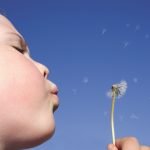Virender Sodhi, ND, MD (Ayurved)
When it comes to the health of their children, today’s parents often feel overwhelmed. The moment a child is born, modern medicine begins to intervene. The timetable of childhood immunizations kicks into gear, with many shots and vaccines recommended during the early months of a child’s life. Wanting to provide the best care for their children, many parents surrender to the advice of their doctors without question.
Evidence is mounting that some vaccines, particularly the MMR vaccine given for measles, mumps and rubella, may be something of a Trojan horse; apparently beneficial, but nevertheless carrying negative elements. While the rate of infection with measles in children in North America has declined significantly, the rates of autism and childhood asthma are exploding. Developments such as these indicate that while modern medicine offers solutions, it inherently neglects the integrated, whole-body approach that natural, herb-based medical traditions have offered for centuries.
In particular, modern approaches almost never deal with the effects of diet in children’s health. Children in the United States and Canada are assaulted daily by environmental and dietary toxins. The diet of the typical American child provides extremely poor nutrition, and assaults the body with toxins from pesticides, chemical fertilizers and food additives. Food allergies in children are quite common, and most parents are unaware of how to alter their child’s diet to improve overall health and prevent serious disease.
In Ayurveda, digestion is seen as central to health. Ayurveda classifies individuals according to body type, and dietary guidelines are used to insure that each person experiences good digestion and thorough elimination. Supplementation with herbs, vitamins and minerals is customized to work with each digestive type. When the Ayurvedic model is applied to growing children, allergies are brought under control, healthy weight is maintained, and optimal growth and development occur. By contrast, under the modern medical approach, dietary changes are almost never used, and when a child becomes sick, the illness is treated by drugs and other interventions which only increase the body’s imbalances.
In my Ayurvedic and naturopathic practice, I have treated thousands of children and adolescents, many of whom experienced significant harm under modern medical treatment. When these children begin to eliminate negative foods from their diet and consume foods beneficial to their body type, remarkable results occur. I have been able to help many young patients withdraw from harmful drugs such as prednisone and other steroids, and have seen regression and even complete reversal of many disease symptoms.
Allergies and Asthma
Ayurveda offers great natural approaches to those who suffer from allergies and asthma, especially children. Every parent should learn how best to help their children when these symptoms occur.
Allergies and asthma may result from seasonal airborne pollens from trees and flowers such as ragweed, from airborne substances such as molds and animal dander, or from pests such as cockroaches and dust mites. Reactions usually begin with allergic rhinitis, which causes pruritic eyes and ears, nasal congestion, sneezing and sometimes sore throat. With increased exposure to the allergens, sinus infections, ear infections, headaches, and low-grade fever may develop.
Reducing the exposure to the allergy-producing substance will usually reduce the symptoms, however sometimes an allergic reaction can be so severe that life-threatening anaphylaxis may occur.
Although hay fever and other allergic reactions can develop at any age, they are most common in children and adolescents. Chemicals, food additives and preservatives can aggravate the child’s allergic symptoms. When the bronchial irritation caused by allergies worsens, reactive airway diseases such as asthma may develop. Studies indicate that 38 percent of allergy sufferers are also asthmatic, while only three to five percent of the general population suffers from asthma.
No matter what the source of their allergies, children and adolescents can benefit from dietary changes. I have found that almost all of my patients with allergies have low digestive levels of hydrochloric acid and an imbalance in intestinal flora, and nutritional changes can address these issues. Mucus-producing foods (known in Ayurveda as kapha foods) should be restricted in the diets of allergy sufferers. These foods include wheat, sugar, potatoes, tomatoes, peppers, bananas, oranges, tangerines, and grapefruit.
For those seeking to reduce mucus, dry grains like chickpeas, kala chana (Bengal gram), corn, buckwheat, amaranth and quinoa are good to eat. For allergy treatment and optimum overall health, I recommend a variety of multi-colored fruits and vegetables – at least five servings every day. Herbal teas are another therapy that is often overlooked in allergy treatment. Hot herb teas of the mucolytic agents Zingiber officinale and Glycyrrhiza glabra can help to eliminate mucus from the system.
Parents of children with allergy problems should also consider the sources of allergens which may exist in the home. Rugs and carpets are major breeding grounds for dust mites. Dust mites are tiny insects which do not cause allergies while alive, but when they die the dried body fragments become airborne and cause allergic reactions in the mucous membranes of the nose, throat, eyes, ears and lungs.
To control household allergens, I advise installing stone, hardwood, or laminated flooring instead of carpeting. Another source of household allergens is the heating system. Electric heating is better than forced air gas furnaces, but if you have gas heat and are unable to change it, then use HEPA filters, which improve indoor air quality. An extra charcoal filter can be used in areas where you spend a lot of time.
Internal body cleansing also helps to control allergy symptoms. I highly recommend sinus cleansing with Neti – a cleansing method which removes allergy-producing substances from the nasal passages gently and thoroughly. Neti is the Ayurvedic douching of the nasal passages with water containing equal parts salt and baking soda. Neti alleviates allergy symptoms while soothing irritated mucous membranes. For children who suffer from allergies, daily sinus cleansing with Neti is as important as brushing their teeth.
Supplementation with herbs, vitamins and minerals also offers excellent protection against allergies. For children and teens with allergies, I recommend 15 mg zinc bid and 500 mg vitamin C tid to boost the immune system. I also prescribe the powerful bioflavonoid quercetin to my patients who suffer from allergies.
Ayurvedic Herbs for Allergies
Several potent Ayurvedic herbs offer tremendous help in controlling allergies in children and adolescents. These include Commiphora mukul (guggul), shilajit, Phyllanthus emblica (amla) and Piper longum (pippali in Sanskrit). I especially recommend guggul supplements when there are underlying food allergies and sinus infections. Guggal acts like a steroid without the side effects. It is also a great anti-inflammatory herb. Guggul has shown remarkable results in treating chronic ear and sinus infections.1 For these I recommend taking a guggul supplement tid for 3-4 months.
Shilajit is a natural mineral pitch that helps boost the immune system.2 One 250 mg capsule of shilajit extract should be taken tid for 3-4 months. Pippali is another powerful antiallergic herb that improves digestion by stimulating gastric secretions.3 Pippli has been shown to block histamine release and to have anti-asthmatic and immunomodulatory effects. Usually I encourage my patients to open up 1-2 capsules of pippli and mix it with raw honey and lick it. The results are amazing; an asthma attack will revert in just a few minutes. Adding one teaspoon of an amla supplement tid to your child’s diet can provide extra protection against allergies.4 Amla is a natural antioxidant and a rich natural source of vitamin C. Tinospora cordifolia (amrita), is an herbaceous vine indigenous to India and has very powerful antiallergic effects. In a study done at Indira Gandhi Medical College in Nagpur, India, 75 patients were randomly given either T. cordifolia or placebo for 8 weeks. They were clinically examined and Hb% (hemoglobin %), TLC (total leukocyte count), DLC (differential leukocyte count) and nasal smear were done. At the end of trial baseline, investigations were repeated, drug decoded and results analyzed. With Tinospora cordifolia treatment, 100% relief was reported from sneezing in 83% patients, in 69% from nasal discharge, in 61% from nasal obstruction and in 71% from nasal pruritus. In the placebo group, there was no relief in 79% from sneezing, in 84.8% from nasal discharge, in 83% from nasal obstruction, and in 88% from nasal pruritus. The difference between Tinospora cordifolia and placebo groups was highly significant. TLC increased in 69% of the patients in the drug-treated group and in only 11% with placebo. After Tinospora cordifolia treatment, eosinophil and neutrophil count decreased and goblet cells were absent in nasal smear. After placebo was given, decrease in eosinophil and neutrophil count was marginal and goblet cells were present.5
I personally have found that a combination of Emblica officinalis (amla), Adhatoda vasica (Malabar nut), Ocimum sanctum (holy basil), T. cordifolia (amrita), Glycyrrhiza glabra, Trikatu (a formula of an equal combination of Piper nigrum, Piper longum and Zingiber), and Terminalia belerica (bahera) works like a charm on allergies and asthma. Most of the pediatric patients of asthma and allergies get almost 100% relief following the above stated protocols. However, not all adult patients of asthma get 100% relief.
Bringing the Ayurvedic Tradition to the United States
I am excited to bring the wealth of Ayurvedic tradition to parents and their children in the United States. It is my hope that increased understanding of the complexities of our children’s health will allow more parents to take advantage of what Ayurveda and naturopathic medicine have to offer. Our children need not continue to suffer from environmental allergies, chronic asthma, obesity and other consequences of a toxic lifestyle and mismanagement of children’s health by the medical establishment. Abundant, safe, natural alternatives exist which can allow children and teens to experience increased energy, greater mental alertness, and optimum protection against disease and chronic imbalance.
Virender Sodhi, ND, MD (Ayurveda) is an internationally respected Ayurvedic and naturopathic physician, and one of the first to practice Ayurvedic medicine in the U.S. He received his MD (Ayurveda) after completing six years of medical training in India. He came to the U.S. in 1986 to share Ayurveda as part of a cultural exchange program. In 1988, Dr. Sodhi graduated from Bastyr University. He treats patients from all over the world at the Ayurvedic and Naturopathic Medical Clinic in Bellevue, Washington. He also lectures extensively throughout both the U.S. and other countries, and is the founder of Ayush Herbs, Inc. Visit www.ayurvedicscience.com.
References:
1. Sharma JN et al. Some pharmacological investigations on the alcoholic extract of triphala alone and in combination with petroleum ether extract of oleogum resin of Commiphora mukul. Indian Drugs. 1988;25(6):220-223.
2. Acharya SB et al. Pharmacological actions of Shilajit. Indian J Exp Biol. 1988;26(10):775-777.
3. Dahanukar SA et al. Anti¬allergic activity of Piper longum. Ind J Pharmacol. 1981;13:122.
4. Rao MRR, Siddiqui HH. Pharmacological studies on Emblica officinalis Gaertn. Ind J Expt Biol. 1964;2-29.
5. Badar VA et al. Efficacy of Tinospora cordifolia in allergic rhinitis. J Ethnopharmacol. 2005;Jan 15;96(3):445-449.





